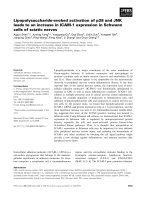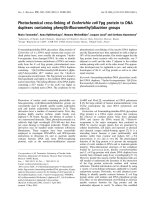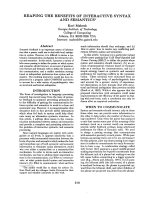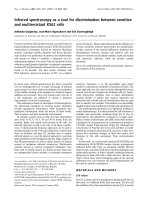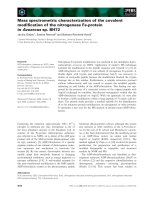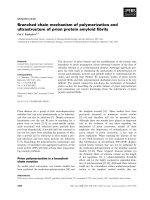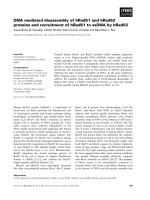Báo cáo khoa học: "Infrared spectroscopy characterization of normal and lung cancer cells originated from epithelium" pdf
Bạn đang xem bản rút gọn của tài liệu. Xem và tải ngay bản đầy đủ của tài liệu tại đây (409.81 KB, 6 trang )
JOURNAL OF
Veterinary
Science
J. Vet. Sci. (2009), 10(4), 299
304
DOI: 10.4142/jvs.2009.10.4.299
*Corresponding author
Tel: +82-2-820-0434; Fax: +82-2-820-0434
E-mail:
Infrared spectroscopy characterization of normal and lung cancer cells
originated from epithelium
So Yeong Lee
1
, Kyong-Ah Yoon
2
, Soo Hwa Jang
1
, Erdene Ochir Ganbold
3
, Dembereldorj Uuriintuya
3
,
Sang-Mo Shin
4
, Pan Dong Ryu
1
, Sang-Woo Joo
3,
*
1
Laboratory of Pharmacology, College of Veterinary Medicine, Seoul National University, Seoul 151-742, Korea
2
Research Institute and Hospital, National Cancer Center, Goyang 410-769, Korea
3
Department of Chemistry, Soongsil University, Seoul 156-743, Korea
4
Department of Mechatronics, Gwangju Institute of Science and Technology, Gwangju 500-712, Korea
The vibrational spectral differences of normal and lung
cancer cells were studied for the development of effective
cancer cell screening by means of attenuated total reflection
infrared spectroscopy. The phosphate monoester symmetric
stretching
ν
s
(PO
3
2
) band intensity at
∼
970 cm
1
and the
phosphodiester symmetric stretching
ν
s
(PO
2
) band intensity
at
∼
1,085 cm
1
in nucleic acids and phospholipids appeared
to be significantly strengthened in lung cancer cells with
respect to the other vibrational bands compared to normal
cells. This finding suggests that more extensive
phosphorylation occur in cancer cells. These results
demonstrate that lung cancer cells may be prescreened
using infrared spectroscopy tools.
Keywords:
cancer cell screening, cell monitoring, infrared
spectroscopy, lung cancers, phosphorylation
Introduction
Cancer is the principal causes of death worldwide according
to the World Health Organization, with lung cancer being
one of the most commonly diagnosed types of cancer in
men and the fourth most common cause of cancer-related
death in men [18]. The early detection of invasive lung
cancer is essential in reducing its mortality rate. It has been
problematic, however, to determine the quantitative
differences in spectral signatures between normal,
precancerous, and cancer cells without causing structural
and biochemical changes.
One of the most popular diagnostic methods in the
clinical assessments of various cancers may be the
microscopic evaluation of a stained biopsy for a specific
organ by pathologists [4]. However, efforts have been made
to improve the early detection rate using spectroscopic
methods [7]. Optical spectroscopy such as Raman [2],
infrared [4], and fluorescence [21] has been shown to be
able to discriminate between normal and malignant tissues
for many cancers. However many physical methods of
cancer analysis are yet either inaccurate or costly.
Infrared vibrational spectroscopy can provide valuable
information about the structure and composition of various
biological materials [4] and has been recently applied to
not only food sciences, but also the veterinary field [10].
Fourier-transform infrared spectroscopy (FT-IR) has been
applied to a variety of phenomena in the biomedical
sciences with fast, automated-data acquisition time and is
inexpensive. The advances in FT-IR technology make it
possible to detect inflammatory and precancerous cell
states with the advantages of a rapid measuring process and
high spatial resolution. This technique enables the study of
the state of chemical bonds and the relative concentrations
of lipids, proteins, carbohydrates, and phosphorylated
compounds [5].
There have been relatively few reports [3,5,6,11,13-17,
19,22,24] monitoring the morphology of cancer cells using
vibrational spectroscopic tools. Although there have been
several infrared spectroscopy studies [20,23] on lung
cancer cell lines, a detailed analysis on the congested
spectral features has not yet been performed. In this study,
we examined the phosphate stretching region using a peak
fitting program revealing various spectral peaks of lung
cancer cell lines to better discriminate between the normal
and lung cancer cells. The vibrational spectra of lung
cancer cells were analyzed by attenuated total reflection
infrared spectroscopy in order to screen for structural and
intracellular alterations in lung cancer cells compared to
normal human bronchial epithelial cells.
300 So Yeong Lee et al.
Tabl e 1 . Spectral data and vibrational assignments of normal and lung cancer cells*
Normal cells
(NHBE
†
)
Cancer cells
(NCI-H358)
Cancer cells
(NCI-H460)
Assignment
‡
1,649
1,548
1,456
1,400
1,235
1,084
972
1,648
1,549
1,456
1,399
1,236
1,086
970
1,645
1,548
1,456
1,400
1,239
1,085
971
Amide I
Amide II
Methyl groups
δ
s
(CH
3
)
Methyl groups
δ
as
(CH
3
)
ν
as
(PO
2
)
ν
s
(PO
2
)
ν
s
(PO
3
2
)
*
Unit (cm
1
). The frequency positions were located at the center of the mixed two bands in Fig. 3.
†
NHBE: normal human bronchial epithelial.
‡
Based on Meurens et al. [15] and Zenobi et al. [26].
Fig. 1. Infrared spectra of (a) normal human bronchial epithelial
(NHBE) and (b) NCI-H358 and (c) NCI-H460 lung cancer cells.
The spectra for each sample were read twice to check
reproducibility. The intensities were normalized with respect to
that of the amide I band at ∼1,650 cm
1
.
Materials and Methods
Cell culture and sample preparation for infrared
spectroscopy
NCI-H358 and NCI-H460 lung cancer cells were grown
on RPMI 1640 (Gibco, USA). The normal human bronchial
epithelial (NHBE) cells were obtained from Cambrex (USA)
and maintained in bronchial epithelial growth medium. All
cells were supplemented with 10% fetal bovine serum and
×1 penicillin-streptomycin antibiotics (Gibco, USA) and
maintained in 5% CO
2
/95% humidified air at 37
o
C.
Approximately 5 × 10
3
cells were washed with phosphate
buffer saline and 0.25% trypsin-EDTA was added for 10
min to detach the cells. After centrifugation at 1,200 rpm
for 10 min, the supernatant was discarded and washed using
phosphate buffered saline. The saline specimens were
centrifuged at 3,000 rpm for several minutes and cell pellets
were transferred to a microcentrifuge and centrifuged at
5,000 rpm for 10 min to provide a small pellet of cells for
FT-IR analysis [19].
Characterization of normal and lung cancer cells
The NCI-H460 lung cancer cells originated from a patient
with large cell cancer of the lung (ATCC catalog number:
HTB-177), which makes up approximately 10∼20% of
lung cancers. The NCI-H358 lung cancer cells were derived
from a primary bronchioalveolar carcinoma of the lung
from a Caucasian patient (ATCC catalog number: CRL-
5807). Primary NHBE cells were used as normal lung cells.
Infrared measurements
The infrared spectra were obtained using a FT-IR
spectrometer with a maximum resolution of 0.09 cm
1
(Thermo Nicolet 6700) equipped with a liquid N
2
cooled
HgCdTe detector [12]. A total of 128 scans were measured
in the range of 1,000∼3,500 cm
1
with a resolution of 4 cm
1
. The prepared lung cancer cell pellet was transferred onto
a ZnSe crystal of Pike Technology Miracle external
reflection accessory. Data processing was carried out using
the OMNIC v5.1a software (Thermo Scientific, USA).
Spectral parameters and fitting of each spectrum was
obtained using a PeakFit version 4.12 (Systat, USA).
Results
Infrared spectra of normal lung cells
Fig. 1a shows the mid-infrared spectra of normal lung
cells. Among several vibrational features, the amide I band
at ∼1,650 cm
1
was due primarily to the C = O stretching
vibrational bands of the peptide backbone. The amide II
band at ∼1,550 cm
1
, due largely to a coupling of CN
stretching and in-plane bending of the N-H group, was also
found to be fairly strong in the infrared spectrum. The two
vibrational bands at ∼1,460 and ∼1,400 cm
1
could be
ascribed to the in-plane bending vibrations of CH
3
. On the
other hand, the vibrational bands at ∼1,235 and ∼1,085
Screening of lung cancer epithelial cells using infrared spectroscopy 301
Tabl e 2 . Intensity ratios with respect to the amide I band
Normal cells
(NHBE)
Cancer cells
(NCI-H358)
Cancer cells
(NCI-H460)
Assignment
*
1.00
0.814
0.124
0.168
0.168
0.274
0.0318
1.00
0.815
0.168
0.171
0.234
0.556
0.140
1.00
0.881
0.152
0.191
0.231
0.426
0.0686
Amide I
Amide II
Methyl groups
δ
s
(CH
3
)
Methyl groups
δ
as
(CH
3
)
ν
as
(PO
2
)
ν
s
(PO
2
)
ν
s
(PO
3
2
)
*
Based on Meurens et al. [15] and Zenobi et al. [26].
cm
1
were assumed to belong to the stretching modes of the
PO
2
group. The weak vibrational band at ∼970 m
1
could
be ascribed to the PO
3
2
group. Our assignment was listed
in Table 1.
Infrared spectra of lung cancer cells
The infrared spectra of lung cancer cells were recorded as
shown in Figs. 1b and c. It is noteworthy that the
ν
s
(PO
3
2
)
and
ν
s
(PO
2
), bands at ∼970 and ∼1,085 cm
1
, respectively,
appeared to be greatly intensified for the two cancer cells in
comparison with normal lung cells. These bands were found
to be the most enhanced for the NCI-H358 cells derived
from a primary bronchioalveolar carcinoma of the lung. It
is remarkable that the spectral difference could be clearly
observed by direct observation of several vibrational bands
in the present study. The relative intensities with respect to
the amide I band are summarized in Table 2. Fig. 2 shows
histograms for the three lung cells of several vibrational
band intensities. An expanded view of infrared spectra in
the wave number range of 900∼1,290 cm
1
for normal and
lung cancer cells are shown in Fig. 3. There were quite a
few spectral features curve fitting under 900∼1,290 cm
1
for normal and lung cancer cells (Fig. 3). In addition to the
ν
s
(PO
3
2
) and ν
s
(PO
2
), bands at ∼970 and ∼1,085 cm
1
,
respectively, there were also bands observed at 916, 1,029,
1,056, 1,118, and 1,155 cm
1
. These bands could be
correlated as carbohydrates or glycoconjugates. In addition,
the
ν
as
(PO
2
) band at ∼1,235 cm
1
can be decomposed to
the two bands at 1,221 and 1,244 cm
1
. One of these two
bands may be ascribed to the torsional mode of CH
2
. These
bands were also found to be slightly different from the
normal or lung cancer cells as shown in Fig. 3. It is
noteworthy that the bands at ∼1,030 and ∼1,155 cm
1
were relatively more enhanced for the normal cell.
Discussion
In the present study, the symmetric ν
s
(PO
2
) band at ∼
1,085 cm
1
and the phosphate monoester symmetric
stretching
ν
s
(PO
3
2
) band intensity at ∼970 cm
1
were
intensified in lung cancer cells compared to normal lung
cells. This may be attributed to structural changes in DNA
or volume density. A similar phenomenon was reported by
Gazi et al. [5] and Maziak et al [14]. According to Gazi et
al. [5] the
ν
s
(PO
2
) bands at ∼1,085 cm
1
were intensified
in prostate cancer tissues compared to normal prostate
epithelial cells. The frequency positions of the
ν
s
(PO
2
) and
ν
as
(PO
2
) bands were also shifted in malignant esophagus
tissue [14].
In addition, the relative intensity factors of Absorbance
ν
s
(PO
3
2
)/Absorbance (amide I) or Absorbance ν
s
(PO
2
)/
Absorbance (amide I) could be used to discriminate lung
cancer cells from normal cells. It is worthwhile to note that
the intensities of the amide I bands appeared to be always
stronger than those of the amide II band without indicating
serious artifact or spectral contamination due to the
dispersion effect in the reflection method as previously
published in our spectral features, [17]. The glycogen level
is assumed to decrease during carcinogenesis, resulting in
a decrease in their intensities as previous reported [24]. It
seems clear that the
ν
s
(PO
3
2
) and ν
s
(PO
2
) bands at ∼970
and ∼1,085 cm
1
, respectively, may provide significant
differences between normal and lung cancer cells. Based
on the spectral data, our conclusions appeared to be
consistent with several previous reports [20,23]. In this
work we mainly focus on the analyses of multiple spectral
features in the infrared spectra of lung cancer cells. Protein
phosphorylation is involved in many cellular regulatory
processes [8]. For example, the phosphorylation of p53,
which is a tumor suppressor, is important in the regulation
of p53 activities [9]. In tumor cells, deregulation, including
the phosphorylation modification of p53, is frequently
observed in tumor cells and known to be associated with
tumorigenesis [1,25].
There are several tools to identify cancer cells and cancer
diagnosis. Compared to the established techniques, the IR
method is relatively inexpensive, fast and can be automated.
Moreover, it checks cells in their natural state without the
302 So Yeong Lee et al.
Fig. 2. Relative band intensities for NCI-H358 and NCI-H460 lung cancer cells and normal NHBE-P5 cells for (a) ν
s
(PO
3
2
), (b) ν
s
(PO
2
), (c)
ν
as
(PO
2
), (d) δ
as
(CH
3
), (e) δ
s
(CH
3
), (f) amide II, and (g) amide I bands. The intensities were normalized for the amide I bands at ∼1,650 cm
1
.
Screening of lung cancer epithelial cells using infrared spectroscopy 303
Fig. 3. Spectral curve fitting of (a) NHBE and (b) NCI-H358 an
d
(c) NCI-H460 lung cancer cells in the wavenumber region of 900∼
1,290 cm
1
. Each sample was tested twice to check the spectral
reproducibility. The y-axis scale is the absorbance in arbitrary
units.
need for fixation and/or staining [4,19].
In the present study, it was found that the phosphate and
phosphodiester stretching bands clearly discriminated
between normal and primary bronchioalveolar carcinoma
cells. These results suggest that greater phosphorylation
occurs in lung cancer cells compared to normal bronchial
epithelial cells. Taken together, these results demonstrate
that lung cancer cells may be prescreened by means of
infrared spectroscopy based tools.
Acknowledgments
This research was supported by National Research
Foundation Grant (2009-0066580).
References
1. Bode AM, Dong Z. Post-translational modification of p53
in tumorigenesis. Nat Rev Cancer 2004, 4, 793-805.
2. Choi J, Choo J, Chung H, Gweon DG, Park J, Kim HJ,
Park S, Oh CH. Direct observation of spectral differences
between normal and basal cell carcinoma (BCC) tissues
using confocal Raman microscopy. Biopolymers 2005, 77,
264-272.
3. Cohenford MA, Rigas B. Cytologically normal cells from
neoplastic cervical samples display extensive structural
abnormalities on IR spectroscopy: Implications for tumor
biology. Proc Natl Acad Sci USA 1998, 95, 15327-15332.
4. Dukor RK. Vibrational spectroscopy in the detection of
cancer. In: Chalmers JM, Griffiths PR (eds.). Handbook of
Vibrational Spectroscopy. Vol. 5. pp. 3335-3361, Wiley,
New York, 2002.
5. Gazi E, Dwyer J, Lockyer NP, Gardner P, Shanks JH,
Roulson J, Hart CA, Clarke NW, Brown MD. Biomolecular
profiling of metastatic prostate cancer cells in bone marrow
tissue using FTIR microspectroscopy: a pilot study. Anal
Bioanal Chem 2007, 387, 1621-1631.
6. Hammiche A, German MJ, Hewitt R, Pollock HM,
Martin FL. Monitoring cell cycle distributions in MCF-7
cells using near-field photothermal microspectroscopy.
Biophys J 2005, 88, 3699-3706.
7. Hirsch FR, Franklin WA, Gazdar AF, Bunn PA Jr. Early
detection of lung cancer: clinical perspectives of recent
advances in biology and radiology. Clin Cancer Res 2001, 7,
5-22.
8. Hunter T, Karin M. The regulation of transcription by
phosphorylation. Cell 1992, 70, 375-387.
9. Ko LJ, Prives C. p53: puzzle and paradigm. Genes Dev
1996 10, 1054-1072.
10. Kohlenberg E, Payette JR, Sowa MG, Levasseur MA,
Riley CB, Leonardi L. Determining intestinal viability by
near infrared spectroscopy: A veterinary application. Vib
Spectrosc 2005, 38, 223-228.
11. Krishna CM, Kegelaer G, Adt I, Rubin S, Kartha VB,
Manfait M, Sockalingum GD. Combined Fourier transform
infrared and Raman spectroscopic approach for identification
of multidrug resistance phenotype in cancer cell lines.
Biopolymers 2006, 82, 462-470.
12. Lim JK, Lee Y, Lee K, Gong M, Joo SW. Reversible
thermochromic change of molecular architecture for A
diacetylene derivative 10,12-pentacosadiynoic acid thin
films on Ag surfaces. Chem Lett 2007, 36, 1226-1227.
13. Liu C, Zhang Y, Yan X, Zhang X, Li C, Yang W, Shi D.
Infrared absorption of human breast tissues in vitro. J
Luminescence 2006, 119-120, 132-136.
14. Maziak DE, Do MT, Shamji FM, Sundaresan SR, Perkins
DG, Wong PTT. Fourier-transform infrared spectroscopic
study of characteristic molecular structure in cancer cells of
esophagus: An exploratory study. Cancer Detect Prev 2007,
31, 244-253.
15. Meurens M, Wallon J, Tong J, No
ël H, Haot J. Breast
cancer detection by Fourier transform infrared spectrometry.
Vib Spectrosc 1996, 10, 341-346.
16. Mordechai S, Sahu RK, Hammody Z, Mark S,
Kantarovich K, Guterman H, Podshyvalov A, Goldstein
J, Argov S. Possible common biomarkers from FTIR
microspectroscopy of cervical cancer and melanoma. J
Microsc 2004, 215, 86-91.
17. Romeo M, Diem M. Correction of dispersive line shape
artifact observed in diffuse reflection infrared spectroscopy
and absorption/reflection (transflection) infrared micro-
spectroscopy. Vib Spectrosc 2005, 38, 129-132.
18. Ruddon RW. Cancer Biology. pp. 3-16, Oxford University
Press, Oxford, 2007.
19. Sindhuphak R, Issaravanich S, Udomprasertgul V,
Srisookho P, Warakamin S, Sindhuphak S, Boonbundarlchai
R, Dusitsin N. A new approach for the detection of cervical
cancer in Thai women. Gynecol Oncol 2003, 90, 10-14.
20. Sul
é-Suso J, Skingsley D, Sockalingum GD, Kohler A,
Kegelaer G, Manfait M, El Haj AJ. FT-IR microspectroscopy
as a tool to assess lung cancer cells response to chemotherapy.
Vib Spectrosc 2005, 38, 179-184.
21. Torrance CJ, Agrawal V, Vogelstein B, Kinzler KW. Use
304 So Yeong Lee et al.
of isogenic human cancers cells for high-throughput screening
and drug discovery. Nat Biotechnol 2001, 19, 940-945.
22. Walsh MJ, German MJ, Singh M, Pollock HM, Hammiche
A, Kyrgiou M, Stringfellow HF, Paraskevaidis E, Martin-
Hirsch PL, Martin FL. IR microspectroscopy: potential
applications in cervical cancer screening. Cancer Lett 2007,
246, 1-11.
23. Wang HP, Wang HC, Huang YJ. Microscopic FTIR
studies of lung cancer cells in pleural fluid. Sci Total Environ
1997, 204, 283-287.
24. Wong PTT, Wong RK, Caputo TA, Godwin TA, Rigas B.
Infrared spectroscopy of exfoliated human cervical cells:
evidence of extensive structural changes during carcinogenesis.
Proc Natl Acad Sci USA 1991, 88, 10988-10992.
25. Zhang W, McClain C, Gau JP, Guo XYD, Deisseroth AB.
Hyperphosphorylation of p53 induced by okadaic acid
attenuates its transcriptional activation function. Cancer Res
1994, 54, 4448-4453.
26. Zenobi MC, Luengo CV, Avena MJ, Rueda EH. An
ATR-FTIR study of different phosphonic acids in aqueous
solution. Spectrochim Acta A Mol Biomol Spectrosc 2008,
70, 270-276.

